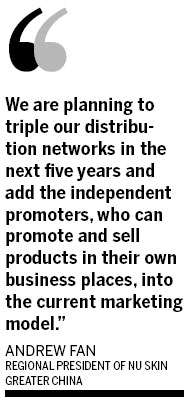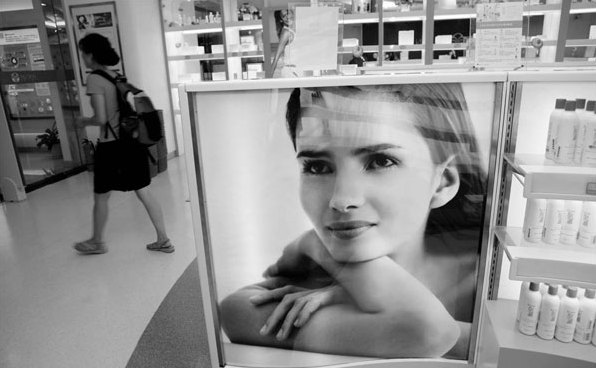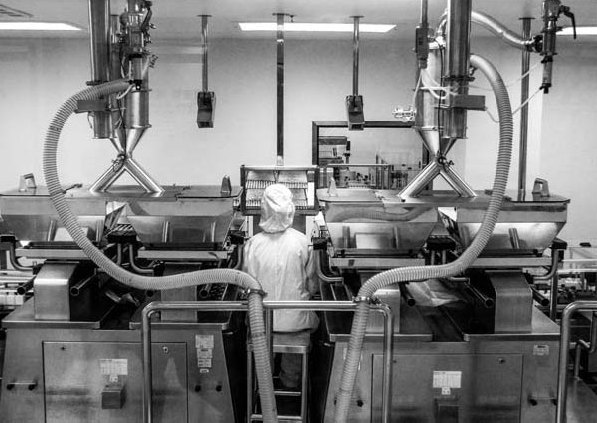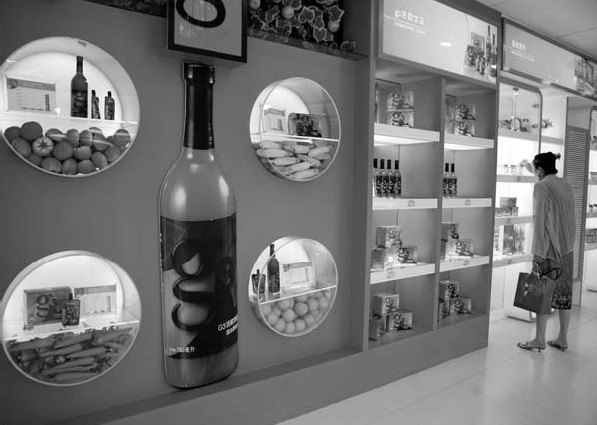Foreign firms show way in direct selling
Mary Kay, Nu Skin, Amway gained solid ground in China's marketplace
Rumors about direct selling have never disappeared since the marketing form sneaked into China 20 years ago. Meanwhile, industry has been struggling to jump on track. Right now, it is burgeoning in the laggard marketplace, led by foreign branded companies.
"The direct-selling industry in China is growing at more than 20 percent year-on-year. It is predicted to keep increasing to hit 1 trillion yuan ($163.4 trillion) in less than 10 years," said Hu Yuanjiang, secretary-general of the Direct Selling Expert Committee of the China Marketing Association.
The Chinese direct selling industry totaled 169.68 billion yuan in 2012, up from a breakthrough of 100 billion yuan in 2009, according to a report released during the Asia-Pacific Direct Selling Forum, which was held in June in Hainan province.
|
The Nu Skin lifestyle store in Beijing. Provided to China Daily |
|
A manufacturing base of Amway (China) Co Ltd in Guangzhou, Guangdong province. The company invested 600 million yuan in building its first global planting R&D center in Wuxi, and its factory in Guangzhou, which will mainly expand the manufacture of its flagship brand, Nutrilite. Provided to China Daily |
|
The lifestyle store of Nu Skin in Beijing. Entering the Chinese market in 2003, Nu Skin has established five manufacturing plants, two R&D centers, as well as 48 boutiques and stores, with an investment of 3 billion yuan up to the end of 2012. Provided to China Daily |
In order to provide an operational environment for industry players, as cheating and illegality were always connected with direct selling at the initial stage, the central government issued Regulations on Administration of Direct Sales in 2005. Right now, nearly 40 players have got an official license, and an increasing number of companies are waiting to be approved.
"Currently, foreign companies are sharing a big slice of the market because they have richer research and development capabilities, more cash flows, better management experience and have established recognizable brands in developed markets," said Hu.
Among those forerunners, Mary Kay, Nu Skin, Amway, and other foreign companies have gained solid ground in the marketplace and keep revamping market strategies to maintain their competitive edge.
As for Nu Skin Enterprises, a United States-based direct-selling company, its revenue in Greater China amounted to $269.1 million in the second quarter of 2013, up 35 percent compared with the same period last year.
"Mirroring our total global revenue of $682.9 million in the second quarter, I think China is playing a bigger role in our company's global expansion," said Andrew Fan, regional president of Nu Skin Greater China.
Entering the Chinese market in 2003, Nu Skin has established five manufacturing plants, two R&D centers, as well as 48 boutiques and stores, with an investment of 3 billion yuan up to the end of 2012. Later this year, its Greater China Innovation Park will be opened, and this is also the company's biggest overseas investment till then.
"This shows our determination in further exploring the Chinese market," said Fan.
Featuring anti-aging products, the company is selling more than 200 categories of anti-aging and nutrition products, including its flagship brand ageLOC, with ageLOC Transformation System, ageLOC Galvanic Spa and Body Spa, and nutrition product portfolio, Pharmanex, priced at 200 yuan to 600 yuan.
"We are planning to triple our distribution networks in the next five years and add the independent promoters, who can promote and sell products in their own business places, into the current marketing model," Fan said.
Although more competitors are joining in the battle, Fan said Nu Skin will stick to focusing on the niche anti-aging sector, as the proportion of aging people will jump to 25.4 percent by 2033, and one-third by 2050, according to the Ministry of Human Resources and Social Security.

"We are not competing with other direct-selling companies in this field, and we have advantages over technology and marketing," Fan said.
Different from Nu Skin, Amway is diversifying its products, while the 50-year-old Mary Kay Inc is planning to march into male skincare products and the healthcare sector.
"China is Mary Kay's only manufacturing plant outside of the US, and China is the company's biggest overseas market right now," said Paul Mak, president of Mary Kay in China.
Mak refused to reveal the sales figures in China as it is not a listed company, but he said the company has developed about 190,000 salespeople, and its year-on-year growth is remaining above a three-digit number in China.
"We are improving our brand and service in matured markets in big cities to compete with numerous retailing cosmetics brands. At the same time, we are speeding up digging out smaller cities, as we have established seven distribution centers around the country to assure an immediate delivery," he said.
Amway has also witnessed Chinese consumers' path of increasing understanding about direct selling in the past 18 years.
"Amway China reached a total turnover of 27.1 billion yuan in 2012, which accounted for one-third of the company's global revenue," said Yu Fang, vice-president of Public Affairs, Amway (China) Co Ltd.
The player invested 600 million yuan in building its first global planting research and development center in Wuxi, focusing on organic planting technology, herbal medicine healthcare products and cosmetics, as well as the second phase of its factory in Guangzhou, which will mainly expand the manufacture of its flagship brand, Nutrilite.
Although Yu is confident with its consulting marketing strategy in the way of face-to-face, one-to-one tailored service, she is worried about hurdles in managing and leading its sales team as they are scattered and floating.
"Amway needs to attract more talents to enhance customers' consumption experience, promote digital applications, and generate creative strategies," said Yu.
In general, direct-selling companies have been struggling to shed a bad impression as a messy market and a less convinced marketing strategy among Chinese consumers.
Direct selling represented only 1 percent of total retailing value in China in 2012, the third smallest among all channels, only bigger than vending and homeshopping in value terms, according to Direct Selling in China released by Euromonitor International.
"In fact, direct selling is just another way of marketing and we are faced with the same customers and brand-building challenge as our retailing competitors," said Mak of Mary Kay.
In Mak's opinion, in recent years, the direct-selling industry has been running faster than retailing business overall in the background of the sluggish global economy, especially in developed markets. Faced with rising unemployment, people tend to be more prudent in shopping in retailing, he said.
"However, the decreasing economy always pushes more people into a direct selling career, and with increasing salespeople, the performance of our products are also being promoted," said Mak.
Of course, he said with the booming of the industry, more local players are betting on the business and the number of local direct selling companies has surpassed 40 percent of the total number.
"Local companies are growing very fast. But the story of increasing competitors has also added the homogenization of the industry in terms of brand building, marketing and product strategies," said Yu Fang from Amway.
Still, as a young industry of just more than 20 years, Hu, from the association, said the further development of direct selling depends on the further improvement of the legal and regulating system to bring it in line with the global direct-selling market.
"As for salespeople and companies, they have to develop a career based on products and services, not playing with opportunities and investments," said Hu.
yaojing@chinadaily.com.cn
(China Daily 10/03/2013 page8)

















